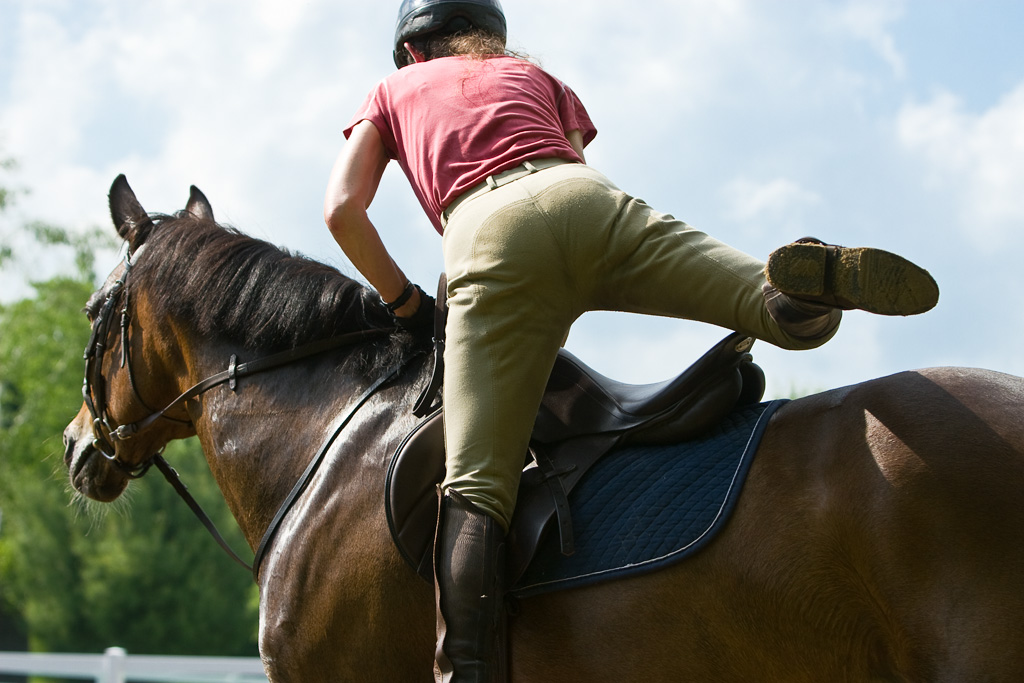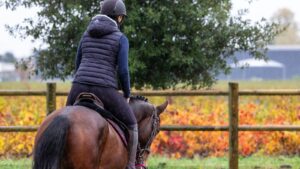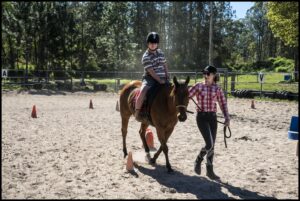Step into the world of power and grace, where strength and serenity unite to create a force like no other. Welcome to the realm of horse training techniques – a realm that has captivated humans for countless centuries. Beyond the majestic gallops and elegant jumps lies a wealth of knowledge and wisdom that extends far beyond the equine world. It is a treasure trove waiting to be explored by individuals seeking to enhance their own performance, tapping into the secret formula that cultivates discipline, resilience, and an unwavering focus. Prepare to embark on a journey like no other, where the bond between human and horse unlocks the true potential lying dormant within each one of us. Get ready to ignite your passion for self-improvement, as we delve into the fascinating world of horse training techniques and discover how they can revolutionize our own pursuit of greatness.
Mind Over Matter: The Psychology Behind Equine Training Methods
Enhance Performance: Harness the Power of Horse Training Techniques!
When it comes to horse training, the key lies in understanding the psychology behind these magnificent creatures. Mind over matter plays a crucial role in shaping their performance, making it essential for trainers to harness the power of effective training techniques. By delving into the intricate workings of equine psychology, trainers can unlock hidden potential and take their horses to new heights.
One of the fundamental principles of equine training is the establishment of trust and mutual respect between the horse and the trainer. Through consistent positive reinforcement and clear communication, horses can develop a deep bond and a willingness to perform at their best. Utilizing techniques such as clicker training, where a click is followed by a reward, can help horses associate desired behaviors with positive outcomes. This reinforcement-based approach allows trainers to shape their horse’s actions, leading to increased focus, obedience, and improved overall performance.
Moreover, understanding the importance of body language and non-verbal cues is vital in effective equine training. Horses are highly perceptive animals, capable of sensing even the slightest shift in their trainer’s demeanor. By maintaining calm and assertive body language, trainers can convey their intentions clearly and establish a sense of leadership. Consistency and patience are key here, as horses learn to respond to these cues over time, resulting in enhanced focus, trust, and ultimately, improved performance.
Key Takeaways:
- Establish trust and mutual respect through positive reinforcement and clear communication.
- Utilize techniques like clicker training to associate desired behaviors with positive outcomes.
- Maintain calm and assertive body language to convey intentions and establish leadership.
| Tip | Use treats or rewards that your horse finds especially enticing to motivate and reinforce positive behaviors. |
| Fact | Horses have a highly developed sense of hearing, making verbal cues an important aspect of training. |
| Quote | “The horse is a mirror to your soul, and sometimes you might not like what you see in the mirror. Sometimes, you will.” – Buck Brannaman |
Unleashing the Potential: Exploring Effective Horse Training Techniques
When it comes to enhancing performance and harnessing the power of horse training techniques, there are a plethora of strategies worth exploring. Whether you’re a seasoned rider or a novice enthusiast, understanding these methods can make a world of difference in your bond and communication with your equine companion. In this post, we delve into three effective training techniques that will unlock your horse’s true potential.
1. Positive Reinforcement: Reward-Based Training
Positive reinforcement is a powerful tool that encourages horses to repeat desired behaviors by associating them with rewards. This technique focuses on praising and rewarding the horse for correct responses, reinforcing the understanding that cooperation will result in positive outcomes. By incorporating treats, pats, or verbal praise into the training process, horses become motivated, engaged, and eager to learn.
2. Clicker Training: An Audible Cue of Success
Clicker training, based on the principles of operant conditioning, utilizes an audible cue, such as the sound of a clicker device, to mark desired behaviors. This technique facilitates clear communication between rider and horse, providing precise timing for rewarding correct actions. Through consistent clicker training, horses quickly grasp the connection between their actions and the auditory cue, enhancing their learning and responsiveness.
3. Groundwork: Laying the Foundation
Groundwork is an essential training technique that establishes the foundation for a successful horse-rider partnership. It involves exercises performed from the ground, promoting trust, respect, and cooperation. These exercises can include leading, lunging, desensitization, and obstacle courses. Groundwork not only enhances communication and obedience but also builds confidence, balance, and strength in horses, setting them up for success under saddle.
| Technique | Main Purpose | Benefits |
|---|---|---|
| Positive Reinforcement | Encourages desired behaviors through rewards | Increases motivation, engagement, and bonding |
| Clicker Training | Marks desired behaviors with an audible cue | Improves timing, communication, and responsiveness |
| Groundwork | Establishes foundation for horse-rider partnership | Builds trust, respect, obedience, confidence, and strength |
From Groundwork to Greatness: Mastering the Art of Horse Training
Enhance Performance: Harness the Power of Horse Training Techniques!
Paving the path towards greatness begins with laying down the groundwork through effective horse training techniques. Mastering this art is not only crucial for the rider’s safety but also vital for the horse’s physical and mental well-being. By understanding the fundamentals of horse training and adopting proven strategies, you can enhance performance and unlock the true potential of your equine partner. Here are some powerful training techniques to help you on your journey to greatness:
1. Building a Strong Foundation
Just like a sturdy building, a well-trained horse starts with a solid foundation. Begin by establishing trust, respect, and clear communication between you and your horse. Spend quality time building a strong connection filled with positive reinforcement, patience, and consistency. Through groundwork exercises such as leading, lunging, and desensitization, you can cultivate a well-rounded horse that is attentive, responsive, and willing to learn.
- Focus on establishing trust and respect through consistent leadership.
- Use positive reinforcement techniques to reward desired behaviors.
- Practice regular groundwork exercises to build body awareness and obedience.
2. Progressive Training Methods
Once the foundation is solid, progressive training methods can take your horse’s skills to new heights. Introduce a structured training program that challenges both you and your horse while gradually increasing the level of difficulty. Break down complex tasks into smaller, achievable steps, ensuring that each lesson builds on the previous one. Employ proven techniques such as rhythm and balance exercises, transitions, lateral movements, and collection to refine your horse’s movements and enhance their overall performance.
- Implement a structured training program that gradually increases difficulty.
- Break down complex tasks into manageable steps for easy comprehension.
- Incorporate exercises that promote rhythm, balance, transitions, and lateral movements.
3. Continuous Learning and Adaptation
Horse training is a dynamic process that requires continuous learning and adaptation. Stay open to new ideas and techniques, seeking guidance from experienced trainers and professionals in the field. Attend clinics, workshops, and seminars to broaden your knowledge and gain insight into innovative training methods. Remember, each horse is unique, and what works for one may not work for another. Stay attuned to your horse’s individual needs and adjust your training techniques accordingly to foster growth and further their success.
- Pursue continuous learning through clinics, workshops, and educational events.
- Seek guidance from experienced trainers and professionals for valuable insights.
- Adapt your training techniques to cater to your horse’s individual needs and capabilities.
Remember, mastering the art of horse training is an ongoing journey that requires dedication, perseverance, and a deep connection with your equine partner. By applying these powerful techniques, you can take significant strides towards enhancing performance, unlocking your horse’s true potential, and reaching new levels of greatness in your equestrian pursuits.
Boosting Performance: Top Tips for Incorporating Horse Training into Your Routine
Enhance Performance: Harness the Power of Horse Training Techniques!
1. Consistency is Key
Consistency is crucial when incorporating horse training into your routine. Establish a regular training schedule and stick to it. Horses thrive on routine and repetition, and maintaining a consistent training schedule will help them develop muscle memory and build confidence.
Make sure to allocate dedicated time for training each day, even if it’s just a short session. Consistency builds trust, develops a strong bond between you and your horse, and enhances their overall performance.
2. Utilize Positive Reinforcement
Positive reinforcement is a powerful tool for horse training. Rewarding your horse with treats, praise, or a gentle pat on the neck can have a significant impact on their motivation and willingness to learn.
When your horse successfully executes a desired behavior or task, immediately praise them and provide a reward. This helps reinforce positive behavior and encourages them to repeat it in the future. Remember, horses are intelligent animals that respond well to positive reinforcement techniques.
3. Adapt and Evolve Training Methods
Every horse is unique, and what works for one may not work for another. It’s essential to adapt and evolve your training methods to meet the specific needs and personality of your horse.
Observe and listen to your horse’s cues and responses during training. If a technique isn’t yielding the desired results, don’t be afraid to try a different approach. Experiment with various exercises, groundwork, or even incorporating obstacles to keep your horse engaged and challenged.
| Training Time | Training Purpose |
|---|---|
| Morning | Warm-up exercises, stretching, and light lunging |
| Afternoon | Focus on specific disciplines such as dressage or jumping |
| Evening | Cool-down exercises, trail rides, or clicker training |
As we bid farewell to this captivating exploration into the world of horse training techniques, we can’t help but be in awe of the profound lessons we’ve learned. From the majestic connection formed between humans and horses, to the subtle artistry of communication, these remarkable creatures have imparted wisdom that transcends the boundaries of the equestrian realm.
Through the depths of their enigmatic eyes, horses have revealed to us the true essence of perseverance, trust, and harmony. Their training techniques, much like a symphony, harmoniously blend discipline, patience, and intuition. With each hoofbeat and graceful movement, they remind us that harnessing the power within ourselves can propel our performance to unimaginable heights.
The journey into understanding these techniques has unlocked a treasure trove of knowledge that extends far beyond the riding arena. The astute observation, adaptability, and resilience demonstrated by these magnificent animals serve as an invaluable blueprint for our own lives. Whether you’re an athlete seeking to enhance your performance, a professional yearning to excel in your field, or simply an individual seeking personal growth, the equine world has countless insights to offer.
By drawing from the artistry of horse training, we begin to unravel the potential within ourselves. Through the gentle guidance of these magnificent beings, we uncover the secrets to unlocking our own hidden talents and abilities. Their gentle nudges and unwavering dedication propel us forward, illuminating our path towards greatness.
So, as we conclude this enlightening exploration, let us take a moment to reflect on the transformative power of horse training techniques. Let us internalize the profound impact they can have on our lives; reminding us to listen to our instincts, forge unbreakable connections, and transcend the limits we once believed to be insurmountable.
May the wisdom gained from these majestic creatures inspire us to embark on our own personal journeys, armed with the tools to enhance our performance, surpass our goals, and live our lives to their fullest potential. With the power of horse training techniques firmly within our grasp, we are now poised to embrace the greatness that awaits us.



